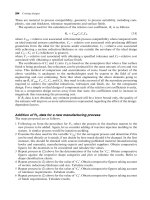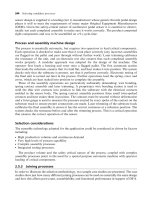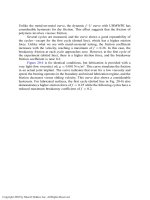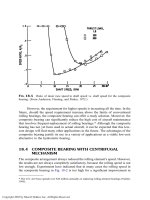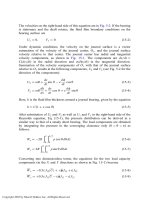Bearing Design in Machinery Episode 2 Part 5 potx
Bạn đang xem bản rút gọn của tài liệu. Xem và tải ngay bản đầy đủ của tài liệu tại đây (176.97 KB, 19 trang )
Problems
10-1 A circular hydrostatic pad as shown in Fig. 10-1 has a constant
supply pressure, p
s
. The circular pad is supporting a load of
W ¼ 1000 N. The outside disk diameter is 200 mm, and the
diameter of the circular recess is 100 mm. The oil is SAE 10 at an
operating temperature of 70
C, having a viscosity of m ¼
0:01 N-s=m
2
. The pad is operating with a clearance of 120 mm.
a. Calculate the flow rate Q of oil through the bearing to
maintain the clearance of 120 mm.
b. Find the recess pressure, p
r
.
c. Find the effective area of this pad.
d. If the supply pressure is twice the recess pressure,
p
s
¼ 2p
r
, find the stiffness of the circular pad.
10-2 A circular hydrostatic pad, as shown in Fig. 10-1, has a constant
flow rate Q. The circular pad is supporting a load of W ¼ 1000 N.
The outside disk diameter is 200 mm, and the diameter of the
circular recess is 100 mm. The oil is SAE 10 at an operating
temperature of 70
C, having a viscosity of m ¼ 0:01 N-s=m
2
. The
pad is operating with a clearance of 120 mm.
a. Calculate the constant flow rate Q of oil through the
bearing to maintain the clearance of 120 mm.
b. Find the recess pressure, p
r
.
c. Find the effective area of this pad.
d. For a constant flow rate, find the stiffness of the circular
pad operating under the conditions in this problem.
10-3 A long rectangular hydrostatic pad, as shown in Fig. 10-3, has
constant flow rate Q. The pad is supporting a load of
W ¼ 10;000 N. The outside dimensions of the rectangular pad
are: length is 300 mm and width is 60 mm. The inside dimensions
of the central rectangular recess are: length is 200 mm and width is
40 mm. The pad is operating with a clearance of 100 mm. The oil is
SAE 20 at an operating temperature of 60
C. Assume that the
leakage in the direction of length is negligible in comparison to that
in the width direction (the equations for two-dimensional flow of a
long pad apply).
a. Calculate the constant flow rate Q of oil through the
bearing to maintain the clearance of 100 mm.
b. Find the recess pressure, p
r
.
Copyright 2003 by Marcel Dekker, Inc. All Rights Reserved.
c. Find the effective area of this pad.
d. For a constant flow rate, find the stiffness of the rectangular
long pad operating under the conditions in this problem.
10-4 A slider-plate in a machine tool is supported by four bidirectional
hydrostatic circular pads. Each recess is fed by a separate pump and
has a constant flow rate. Each bidirectional pad is as shown in Fig.
10-3 (but it is a circular and not a rectangular pad). The weight of
the slider is 20,000 N, or 5000 N on each pad. The total manufac-
tured clearance between the two pads ðh
1
þ h
2
Þ is 0.4 mm. Each
circular pad is of 100-mm diameter and recess diameter of 50 mm.
R ¼ 50 mm and R
0
¼ 25 mm. The oil viscosity is 0:01 N-s=m
2
.In
order to minimize vertical displacement, the slider plate is
prestressed. The reaction force at the top is W
1
¼ 5000 N, and the
reaction at the bottom is W
2
¼ 10;000 N (reaction to the top bearing
reaction plus weight).
a. Find Q
1
and Q
2
in order that the two clearances will be
equal ðh
1
¼ h
2
Þ.
b. If the flow rate is the same at the bottom and top pads, find
the magnitude of the two clearances, h
1
and h
2
. What is the
equal flow rate, Q, into the two pads?
c. For the first case of equal clearances, find the stiffness of
each pad. Add them together for the stiffness of the slider.
d. For the first case of equal clearances, if we place an extra
vertical load of 40 N on the slider (10 N on each pad), find
the downward vertical displacement of the slider.
10-5 In a machine tool, hydrostatic bearings support the slide plate as
shown in Fig. 10-4. The supply pressure reaches each recess through
a flow restrictor. The hydrostatic bearings are long rectangular pads.
Two bidirectional hydrostatic pads are positioned along the two
sides of the slider plate. The weight of the slider is 10,000 N, or
5000 N on each pad. The total manufactured clearance between the
two pads ðh
1
þ h
2
Þ¼0:4 mm. The oil viscosity is 0:05 N-s=m
2
.For
minimizing vertical displacement, the slider plate is prestressed. The
reaction of each pad from the top is 5000 N, and the reaction from
the bottom of each pad is 10,000 N (reaction to the top bearing
reaction plus half slider weight). In order to have equal recess
pressure in all pads, the dimensions of the widths of the bottom pad
are double those in the top pad. The dimensions of each rectangular
pad are as follows.
Copyright 2003 by Marcel Dekker, Inc. All Rights Reserved.
Top rectangular pad dimensions: 400 mm long and 30 mm
wide. A rectangular recess is centered inside the rectangular
pad, and its dimensions are 360-mm length and 10-mm
width.
Bottom rectangular pad dimensions: 400-mm length and 60-
mm width. A rectangular recess is centered inside the
rectangular pad and its dimensions are 360-mm length and
20-mm width.
a. Find the recess pressure, p
r
, at the bottom and top recesses.
b. The supply pressure from one pump is twice the recess
pressure, p
s
¼ 2p
r
. Find the supply pressure.
c. Find the flow resistance, R
in
, at the inlet of the bottom and
top recesses in order that the two clearances will be equal
ðh
1
¼ h
2
Þ.
d. The flow resistance is made of a capillary tube of 1-mm ID.
Find the length, l
c
, of the capillary tube at the inlet of the
bottom and top recesses.
e. Find the flow rates Q
1
and Q
2
into the bottom and top
recesses.
f. For equal clearances, find the stiffness of each pad. Add
them together for the stiffness of the bi-directional pad.
g. If we place an extra vertical load of 60 N on the slider (30 N
on each bidirectional pad), find the vertical displacement
(down) of the slider.
10-6 A long rectangular hydrostatic pad, as shown in Fig. 10-3, has a
constant supply pressure, p
s
. The pressure is fed into the recess
through flow restrictors. The pad supports a load of W ¼ 20;000 N.
The outside dimensions of the rectangular pad are: length is 300 mm
and width is 60 mm. The inside dimensions of the central rectan-
gular recess are: length is 200 mm and width is 40 mm. The pad is
designed to operate with a minimum clearance of 100 mm. The oil is
SAE 30 at an operating temperature of 60
C. Assume that the
equations for two-dimensional flow of a long pad apply.
a. Calculate the flow rate Q of oil through the bearing to
maintain the clearance of 100 mm.
b. Find the recess pressure, p
r
.
c. Find the effective area of this pad.
d. If the supply pressure is twice the recess pressure,
p
s
¼ 2p
r
, find the stiffness of the pad.
Copyright 2003 by Marcel Dekker, Inc. All Rights Reserved.
11
Bearing Materials
11.1 FUNDAMENTAL PRINCIPLES OF
TRIBOLOGY
During the twentieth century, there has been an increasing interest in the friction
and wear characteristics of materials. The science of friction and wear of materials
has been named Tribology (the science of rubbing). A lot of research has been
conducted that resulted in significant progress in the understanding of the
fundamental principles of friction and wear of various materials. Several journals
are dedicated to the publication of original research in this subject, and many
reference books have been published where the research findings are presented.
The most important objective of the research in tribology is to reduce friction and
wear as well as other failure modes in bearings. On the other hand, there are many
important applications where it is desirable to maximize friction, such as in
brakes and in the friction between tires and road.
The following is a short review of the fundamental principles of tribology
that are important to practicing engineers. More detailed coverage of the research
work in tribology has been published in several books that are dedicated to this
subject. Included in the tribology literature are books by Bowden and Tabor
(1956), Rabinowicz (1965), Bowden and Tabor (1986), Blau (1995), and Ludema
(1996).
It is well known that sliding surfaces of machine elements have a certain
degree of surface roughness. Even highly polished surfaces are not completely
Copyright 2003 by Marcel Dekker, Inc. All Rights Reserved.
smooth, and this roughness can be observed under the microscope or measured
by a profilometer. The surface roughness is often compared to a mountainous
terrain, where the hills are referred to as surface asperities. The root mean square
(RMS) of the surface roughness is often used to identify the surface finish, and it
can be measured by a profilometer. The RMS roughness value of the best-
polished commercial surfaces is about 0.01–250 mm (micrometers). Sliding
surfaces are separated by the asperities; therefore, the actual contact area between
two surfaces exists only at a few points, where contacts at the tip of the asperities
take place. Each contact area is microscopic, and its size is of the order of 10–
50 mm. Actual total contact area, A
r
, that supports the load is very small relative to
the apparent area (by several orders of magnitude).
A very small contact area at the tip of the surface asperities supports the
external normal load, F, resulting in very high compression stresses at the
contact. The high compression stresses cause elastic as well as plastic deforma-
tion that forms the actual contact area, A
r
. Experiments indicated that the actual
contact area, A
r
, is proportional to the load, F, and the actual contact area is not
significantly affected by the apparent size of the surface. Moreover, the actual
contact area, A
r
, is nearly independent of the roughness value of the two surfaces.
Under load, the contact area increases by elastic and plastic deformation. The
deformation continues until the contact area and compression strength p
h
(of the
softer material) can support the external load, F. The ultimate compression stress
that the softer material can support, p
h
, depends on the material hardness, and the
equation for the normal load is
F ¼ p
h
A
r
ð11-1Þ
The compression strength, p
h
, is also referred to as the penetration hardness,
because the penetration of the hard asperity into the soft one is identical to a
hardness test, such as the Vickers test. For elastic materials, p
h
is about three
times the value of the compression yield stress (Rabinovitz, 1965).
11.1.1 Adhesion Friction
The recent explanation of the friction force is based on the theory of adhesion.
Adhesion force is due to intermolecular forces between two rubbing materials.
Under high contact pressure, the contact areas adhere together in the form of
microscopic junctions. The magnitude of a microscopic junction is about 10–
50 mm; in turn, the friction is a continual process of formation and shearing of the
microscopic junctions. The tangential friction force, F
f
, is the sum of forces
required for continual shearing of all the junction points. This process is repeated
continually as long as an external tangential force, F
f
, is provided to break the
Copyright 2003 by Marcel Dekker, Inc. All Rights Reserved.
adhesion contacts to allow for a relative sliding. The equation for the friction
force is
F
f
¼ t
av
A
r
ð11-2Þ
Here, t
av
is the average shear stress required for shearing the adhesion joints of
the actual adhesion contacts of the total area A
r
. Equation (11-2) indicates that, in
fact, the friction force, F
f
, is proportional to the actual total contact area, A
r
,and
is not affected by the apparent contact area. This explains the Coulomb friction
laws, which state that the friction force F
t
is proportional to the normal force F
n
.
The adhesion force is proportional to the actual area A
r
, which, in turn, is
proportional to the normal force, F, due to the elasticity of the material at the
contact. When the normal force is removed, the elastic deformation recovers and
there is no longer any friction force.
In many cases, the strength of the adhesion joint is higher than that of the
softer material. In such cases, the shear takes place in the softer material, near the
junction, because the fracture takes place at the plane of least resistance. In this
way, there is a material transfer from one surface to another. The average shear
strength, t
av
, is in fact the lower value of two: the junction strength and the shear
strength of the softer material.
The adhesion and shearing of each junction occurs during a very short time
because of its microscopic size. The friction energy is converted into heat, which
is dissipated in the two rubbing materials. In turn, the temperature rises,
particularly at the tip of the asperities. This results in a certain softening of the
material at the contact, and the actual contact areas of adhesion increase, as does
the junction strength.
11.1.2 Compatible Metals
A combination of two metals is compatible for bearing applications if it results in
a low dry friction coefficient and there is a low wear rate. Compatible metals are
often referred to as score resistant, in the sense that the bearing resists fast
scoring, in the form of deep scratches of the surface, which results in bearing
failure.
In general, two materials are compatible if they form two separate phases
after being melted and mixed together; namely, the two metals have very low
solid solubility. In such cases, the adhesion force is a relatively weak bond
between the two surfaces of the sliding metals, resulting in low t
av
. In turn, there
is relatively low friction force between compatible materials. On the other hand,
when the two metals have high solubility with each other (can form an alloy), the
metals are not compatible, and a high friction coefficient is expected in most
cases (Ernst and Merchant, 1940). For example, identical metals are completely
soluble; therefore, they are not compatible for bearing applications, such as steel
Copyright 2003 by Marcel Dekker, Inc. All Rights Reserved.
on steel and copper on copper. Aluminum and mild steel are soluble and have a
high friction coefficient. On the other hand, white metal (babbitt), which is an
alloy of tin, antimony, lead, and copper, is compatible against steel. Steel journal
and white metal bearings have low dry friction and demonstrate outstanding score
resistance.
Roach, et al. (1956) tested a wide range of metals in order to compare their
score resistance (compatibility) against steel. Table 11-1 summarizes the results
by classifying the metals into compatibility classes of good, fair, poor, and very
poor. Good compatibility means that the metal has good score resistance against
steel.
In this table, the atomic number is listed before the element, and the melting
point in degrees Celsius is listed after the element. Cadmium has been found to be
an intermediate between ‘‘good’’ and ‘‘fair’’ and copper an intermediate between
‘‘fair’’ and ‘‘poor.’’ The melting point does not appear to affect the compatibility
with steel. Zinc, for example, has a melting point between those of lead and
antimony, but has poorer compatibility in comparison to the two.
It should be noted that many metals that are classified as having a good
compatibility with steel are the components of white metals (babbitts) that are
widely used as bearing material. Roach et al. (1956) suggested an explanation
that the shear strength at the junctions determines the score resistance. Metals that
are mutually soluble tend to have strong junctions that result in a poor
compatibility (poor score resistance).
However, there are exceptions to this rule. For example, magnesium,
barium, and calcium are not soluble in steel but do not have a good score
resistance against steel. Low friction and score resistance depends on several
other factors. Hard metals do not penetrate into each other and do not have a high
friction coefficient. Humidity also plays an important role, because the moisture
layer acts as a lubricant.
Under light loads, friction results only in a low temperature of the rubbing
surfaces. In such cases, the temperature may not be sufficiently high for the
metals to diffuse into each other. In turn, there would not be a significant score of
the surfaces, although the metals may be mutually soluble. In addition, it has been
suggested that these types of bonds between the atoms, in the boundary of the two
metals, play an important role in compatibility. Certain atomic bonds are more
brittle, and the junctions break easily, resulting in a low friction coefficient.
11.1.3 Coulomb Friction Laws
According to Coulomb (1880), the tangential friction force, F
f
, is not dependent
on the sliding velocity or on the apparent contact area. However, the friction
Copyright 2003 by Marcel Dekker, Inc. All Rights Reserved.
force, F
f
, is proportional to the normal load, F. For this reason, the friction
coefficient, f , is considered to be constant and it is defined as
f ¼
F
f
F
ð11-3Þ
Equation (11-3) is applicable in most practical problems. However, it is already
commonly recognized that the friction laws of Coulomb are only an approxima-
tion. In fact, the friction coefficient is also a function of the sliding velocity, the
temperature, and the magnitude of the normal load, F.
Substituting Eqs. (11-1) and (11-2) into Eq. (11-3) yields the following
expression for the friction coefficient:
f ¼
F
f
F
¼
t
av
p
h
ð11-4Þ
Equation (11-4) is an indication of the requirements for a low friction coefficient
of bearing materials. A desirable combination is of relative high hardness, p
h
, and
low average shear strength, t
av
. High hardness reduces the contact area, while a
low shear strength results in easy breaking of the junctions (at the adhesion area
or at the softer material). A combination of hard materials and low shear strength
usually results in a low friction coefficient.
An example is white metal, which is a multiphase alloy with a low friction
coefficient against steel. The hard phase of the white metal has sufficient
hardness, or an adequate value of p
h
. At the same time, a soft phase forms a
thin overlay on the surface. The soft layer on the surface has mild adhesion with
steel and can shear easily (low t
av
). This combination of a low ratio t
av
=p
h
results
in a low friction coefficient of white metal against steel, which is desirable in
bearings. The explanation is similar for the low friction coefficient of cast iron
against steel. Cast iron has a thin layer of graphite on the surface of very low t
av
.
An additional example is porous bronze filled with PTFE, where a thin layer of
soft PTFE, which has low t
av
, is formed on the surface.
Any reduction of the adhesive energy decreases the friction force. Friction
in a vacuum is higher than in air. The reduction of friction in air is due to the
adsorption of moisture as well as other molecules from the air on the surfaces. In
the absence of lubricant, in most practical cases the friction coefficient varies
between 0.2 and 1. However, friction coefficients as low as 0.05 can be achieved
by the adsorption of boundary lubricants on metal surfaces in practical applica-
tions. All solid lubricants, as well as liquid lubricants, play an important role in
forming a thin layer of low t
av
, and in turn, the friction coefficient is reduced.
In addition to adhesion friction, there are other types of friction. However,
in most cases, adhesion accounts for a significant portion of the friction force. In
most practical cases, adhesion is over 90% of the total friction. Additional types
of the friction are plowing friction, abrasive friction, and viscous shear friction.
Copyright 2003 by Marcel Dekker, Inc. All Rights Reserved.
11.2 WEAR MECHANISMS
Unless the sliding surfaces are completely separated by a lubrication film, a
certain amount of wear is always present. If the sliding materials are compatible,
wear can be mild under appropriate conditions, such as lubrication and moderate
stress. However, undesirably severe wear can develop if these conditions are not
maintained, such as in the case of overloading the bearing or oil starvation. In
addition to the selection of compatible materials and lubrication, the severity of
the wear increases with the surface temperature. The bearing temperature
increases with the sliding speed, V , because the heat, q, that is generated per
unit of time is equal to the mechanical power needed to overcome friction. The
power losses are described according to the equation
q ¼ fFV ð11-5Þ
In the absence of liquid lubricant, heat is removed only by conduction through the
two rubbing materials. The heat is ultimately removed by convection from the
materials to the air. Poor heat conductivity of the bearing material results in
elevated surface temperatures. At high surface temperatures, the friction coeffi-
cient increases with a further rise of temperature. This chain of events often
causes scoring wear and can ultimately cause, under severe conditions, seizure
failure of the bearing. The risk of seizure is particularly high where the bearing
runs without lubrication. In order to prevent severe wear, compatible materials
should always be selected. In addition, the PV value should be limited as well as
the magnitudes of P and V separately.
11.2.1 Adhesive Wear
Adhesive wear is associated with adhesion friction, where strong microscopic
junctions are formed at the tip of the asperities of the sliding surfaces. This wear
can be severe in the absence of lubricant. The junctions must break due to relative
sliding. The break of a junction can take place not exactly at the original interface,
but near it. In this way, small particles of material are transferred from one surface
to another. Some of these particles can become loose, in the form of wear debris.
Severe wear can be expected during the sliding of two incompatible materials
without lubrication, because the materials have strong adhesion.
For two rubbing metals, high adhesion wear is associated with high solid
solubility with each other (such as steel on steel). Adhesion junctions are formed
by the high contact pressure at the tip of the surface asperities. However, much
stronger junctions are generated when the temperature at the junction points is
relatively high. Such strong junctions often cause scoring damage. The source of
elevated surface temperature can be the process, such as in engines or turbines, as
well as friction energy that generates high-temperature hot spots on the rubbing
Copyright 2003 by Marcel Dekker, Inc. All Rights Reserved.
surfaces. When surface temperature exceeds a certain critical value, wear rate will
accelerate. This wear is referred to in the literature as scuffing or scoring, which
can be identified by material removed in the form of lines along the sliding
direction. Overheating can also lead to catastrophic bearing failure in the form of
seizure.
11.2.2 Abrasion Wear
This type of wear occurs in the presence of hard particles, such as sand dust or
metal wear debris between the rubbing surfaces. Also, for rough surfaces,
plowing of one surface by the hard asperities of the other results in abrasive
wear. In properly designed bearings, with adequate lubrication, it is estimated that
85% of wear is due to abrasion. It is possible to reduce abrasion wear by proper
selection of bearing materials. Soft bearing materials, in which the abrasive
particles become embedded, protect the shaft as well as the bearing from
abrasion.
11.2.3 Fatigue Wear
The damage to the bearing surface often results from fatigue. This wear is in the
form of pitting, which can be identified by many shallow pits, where material has
been removed from the surface. This type of wear often occurs in line-contact or
point-contact friction, such as in rolling-element bearings and gears. The
maximum shear stress is below the surface. This often results in fatigue cracks
and eventually causes peeling of the surface material.
In rolling-element bearings, gears, and railway wheels, the wear mechanism
is different from that in journal bearings, because there is a line or point contact
and there are alternating high compression stresses at the contact. In contrast, the
surfaces in journal bearings are conformal, and the compression stresses are more
evenly distributed over a relatively larger area. Therefore, the maximum compres-
sion stress is not as high as in rolling contacts, and adhesive wear is the dominant
wear mechanism. In line and point contact, the surfaces are not conformal, and
fatigue plays an important role in the wear mechanisms, causing pitting, i.e.,
shallow pits on the surface. Fatigue failure can start as surface cracks, which
extend into the material, and eventually small particles become loose.
11.2.4 Corrosion Wear
Corrosion wear is due to chemical attack on the surface, such as in the presence
of acids or water in the lubricant. In particular, a combination of corrosion and
fatigue can often cause an early failure of the bearing.
Copyright 2003 by Marcel Dekker, Inc. All Rights Reserved.
11.3 SELECTION OF BEARING MATERIALS
A large number of publications describe the wear and friction characteristics of
various bearing materials.* However, when it comes to the practical design and
selection of materials, numerous questions arise concerning the application of this
knowledge in practical situations. We must keep in mind that the bearing material
is only one aspect of an integrated bearing design, and even the best and most
expensive materials would not guarantee successful operation if the other design
principles are ignored.
Although hydrodynamic bearings are designed to operate with a full oil
film, direct contact of the material surfaces occurs during starting and stopping.
Some bearings are designed to operate with boundary or mixed lubrication
where there is a direct contact between the asperities of the two surfaces. Proper
material combination is required to minimize friction, wear, and scoring damage
in all bearing types, including those operating with hydrodynamic or hydrostatic
fluid films. In a hydrostatic bearing, the fluid pressure is supplied by an external
pump, and a full fluid film is maintained during starting and stopping. The
hydrostatic fluid film is much thicker in comparison to the hydrodynamic one.
However, previous experience in machinery indicates that the bearing material is
important even in hydrostatic bearings. Experience indicates that there are
always unexpected vibrations and disturbances as well as other deviations
from normal operating conditions. Therefore, the sliding materials are most
likely to have a direct contact, even if the bearing is designed to operate as a full
hydrodynamic or hydrostatic bearing. For example, in a certain design of a
machine tool, the engineers assumed that the hydrostatic bearing maintains full
film lubrication at all times, and selected a steel-on-steel combination. However,
the machines were recalled after a short operating period due to severe bearing
damage.
There is a wide range of bearing materials to select from—metals, plastics,
and composite materials—and there is no one ideal bearing material for all cases.
The selection depends on the application, which includes type of bearing, speed,
load, type of lubrication, and operating conditions, such as temperature and
maximum contact pressure.
In general, a bearing metal should have balanced mechanical properties. On
the one hand, the metal matrix should be soft, with sufficient plasticity to conform
to machining and alignment errors as well as to allow any abrasive particles in the
lubricant to be embedded in the bearing metal. On the other hand, the metal
should have sufficient hardness and compression strength, even at high operating
temperature, to avoid any creep and squeezing flow of the metal under load, as
well as having adequate resistance to fatigue and impact. The selection is a
*Examples are Kennedy et al. (1998), Kingsbury (1997), Blau (1992), Booser (1992), Kaufman
(1980), and Peterson and Winer (1980).
Copyright 2003 by Marcel Dekker, Inc. All Rights Reserved.
tradeoff between these contradictory requirements. For the manufacture of the
bearing, easy melting and casting properties are required. In addition, the bearing
metal must adhere to the steel shell and should not separate from the shell by
metal fatigue.
The following is a discussion of the most important performance char-
acteristics that are usually considered in the selection of bearing materials.
11.3.1 Score and Seizure Resistance
Compatibility between two materials refers to their ability to prevent scoring
damage and seizure under conditions of friction without adequate lubrication.
Compatible materials demonstrate relatively low friction coefficient under dry
and boundary lubrication conditions. In metals, junctions at the tip of the surface
asperities are formed due to high contact pressure. When these junctions are torn
apart by tangential friction force, the surfaces are scored. The high friction energy
raises the surface temperature, and in turn stronger junctions are formed, which
can result in bearing failure by seizure. Similar metals are not compatible because
they tend to have relatively high friction coefficients, e.g., steel on steel. A more
compatible combination would be steel on bronze or steel on white metal. Most
plastic bearings are compatible with steel shafts.
11.3.2 Embedd ability
This is an important characteristic of soft bearing materials, where small hard
particles become embedded in the bearing material and thus prevent abrasion
damage. Dust, such as silica, and metal particles (wear products) are always
present in the oil. These small, hard particles can cause severe damage, in the
form of abrasion, particularly when the oil film is very thin, at low speeds under
high loads. The abrasion damage is more severe whenever there is overheating of
the bearing. When the hard particles are embedded in the soft bearing metal,
abrasion damage is minimized.
11.3.3 Corrosion Resistance
Certain bearing metals are subject to corrosion by lubricating oils containing
acids or by oils that become acidic through oxidation. Oil oxidation takes place
when the oil is exposed to high temperatures for extended periods, such as in
engines. Oxidation inhibitors are commonly added to oils to prevent the
formation of corrosive organic acids. Corrosion fatigue can develop in the
bearing metal in the presence of significant corrosion. Corrosion-resistant
materials should be applied in all applications where corrosives may be present
in the lubricant or the environment. Improved alloys have been developed that are
more corrosion resistant.
Copyright 2003 by Marcel Dekker, Inc. All Rights Reserved.
11.3.4 Fatigue Resistance
In bearings subjected to oscillating loads, such as in engines, conditions for
fatigue failure exist. Bearing failure starts, in most cases, in the form of small
cracks on the surface of the bearing, which extend down into the material and
tend to separate the bearing material from the housing. When sufficiently large
cracks are present in the bearing surface, the oil film deteriorates, and failure by
overheating can be initiated. It is impossible to specify the load that results in
fatigue, because many operating parameters affect the fatigue process, such as
frequency of oscillating load, metal temperature, design of the bearing housing,
and the amount of journal flexure. However, materials with high fatigue resistance
are usually desirable.
11.3.5 Conformability
This is the ability to deform and to compensate for inaccuracy of the bearing
dimensions and its assembly relative to the journal. We have to keep in mind that
there are always manufacturing tolerances, and metal deformation can correct for
some of these inaccuracies. An example is the ability of a material to conform to
misalignment between the bearing and journal. The conformability can be in the
form of plastic or elastic deformation of the bearing and its support. The
characteristic of having large plastic deformation is also referred to as deform-
ability. This property indicates the ability of the material to yield without causing
failure. For example, white metal, which is relatively soft, can plastically deform
to correct for manufacturing errors.
11.3.6 Friction Coe⁄cient
The friction coefficient is a function of many parameters, such as lubrication,
temperature, and speed. Proper selection of the rubbing materials is important,
particularly in dry and boundary lubrication. A low coefficient of friction is
usually desirable in most applications. In most cases, a combination of hard and
soft materials results in a low friction coefficient. A low coefficient of friction is
usually related to the compatibility (score-resistance) characteristic, where partial
welding of the surface asperities occurring at hot spots on the rubbing surfaces
can increase friction.
11.3.7 Porosity
This property indicates the ability of the material to contain fluid or solid
lubricants. An example of a porous metal is sintered bronze, which can be
impregnated with oil or white metal. Such porous bearings offer a significant
Copyright 2003 by Marcel Dekker, Inc. All Rights Reserved.
advantage, of reduction in maintenance cost in applications of boundary lubrica-
tion, where only a small amount of lubricant is required.
11.3.8 Thermal Conductivity
For most applications, a relatively high thermal conductivity improves the
performance of the bearing. The friction energy is dissipated in the bearing as
heat, and rapid heat transfer reduces the operating temperature at the sliding
contact.
11.3.9 Thermal Expansion
The thermal expansion coefficient is an important property in bearing design. It is
desirable that the thermal expansion of the bearing be greater than the journal, to
reduce the risk of thermal seizure. However, if the expansion coefficient is
excessively large in comparison to that of the steel shaft, a very large clearance
would result, such as in plastic bearings. Unique designs with elastic flexibility
are available to overcome the problem of overexpansion.
11.3.10 Compressive Strength
A high compressive strength is required for most applications. The bearing
should be capable of carrying the load at the operating temperature. This
characteristic is in conflict with that of conformability and embeddability. Usually
for high compressive strength, high-hardness bearing material is required. How-
ever, for conformability and embeddability, relatively low hardness values are
desired.
11.3.11 Cost
The bearing material should be cost effective for any particular application. To
reduce the bearing cost, material should be selected that can be manufactured in a
relatively low-cost process. For metals, easy casting and machining properties are
desirable to reduce the manufacturing cost. For metal bearings, a bronze bushing
is considered a simple low-cost solution, while silver is the most expensive.
Plastic bearings are widely used, primarily for their low cost as well as their low-
cost manufacturing process. Most plastic bearings are made in mass production
by injection molding.
11.3.12 Manufacturing
Consideration should be given to the manufacturing process. Bearing metals must
have a relatively low melting point and have good casting properties. Also, they
Copyright 2003 by Marcel Dekker, Inc. All Rights Reserved.
should exhibit good bonding properties, to prevent separation from the backing
material during operation.
11.3.13 Classi¢cation of Bearing Materials
Bearing materials can be metallic or nonmetallic. Included in the metallic
category are several types of white metals (tin and lead-based alloys), bronzes,
aluminum alloys, and porous metals. Certain thin metallic coatings are widely
used, such as white metals, silver, and indium. The nonmetallic bearing materials
include plastics, rubber, carbon-graphite, ceramics, cemented carbides, metal
oxides, glass, and composites, such as glass-fiber- and carbon-fiber-reinforced
PTFE (Teflon).
11.4 METAL BEARINGS
11.4.1 White Metal: Tin- and Lead-Based Alloys
(Babbitts)
Isaac Babbitt invented and in 1839 obtained a U.S. patent on the use of a soft
white alloy for a bearing. This was a tin-based alloy with small amounts of added
copper, antimony, and lead. These alloys are often referred to as babbitts. The
term white metal is used today for tin- as well as lead-based alloys. A white metal
layer is cast as a bearing surface for steel, aluminum, bronze, or cast iron sleeves.
White metal can undergo significant plastic deformation, resulting in excellent
embeddability and conformability characteristics. Hard crystals are dispersed in
the soft matrix and increase the hardness of the alloy, but they do not have a
significant adverse effect on the frictional properties because the soft matrix
spreads out on the surface during sliding to form a thin lubricating film. This
results in a low friction coefficient, since the shearing stress of the soft matrix is
relatively low. The limit to the use of white metals is their relatively low melting
temperature. Also, there are limits to the magnitude of steady compression
pressure—7 N=mm
2
(7 Mpa)—and much lower limits whenever there is fatigue
under oscillating loads. Using very thin layers of white metal can extend the limit.
Of course, the maximum loads must be reduced at elevated temperature, such as
in engines, where the temperature is above 100
C, where white metal loses nearly
50% of its compression strength. Specifications and tables of properties of white
metals are included in ASTM B23 (1990).
White metal has considerable advantages as a bearing material, and it is
recommended as the first choice for most applications. In order to benefit from
these advantages, the design should focus on limiting the peak pressure and
maximum operating temperature. Soft sleeve materials can tolerate some
Copyright 2003 by Marcel Dekker, Inc. All Rights Reserved.
mis-alignment, and dust particles in the oil can be embedded in the soft material,
thus preventing excessive abrasion and wear. However, white metal has a
relatively low melting point and can creep if the maximum pressure is above
its compressive strength. Thin white metal linings offer better resistance to creep
and fatigue; see Fig. 11-1.
At the beginning of the twentieth century, white metal linings were much
thicker (5 mm and more) in comparison to current applications. The requirement to
reduce the size of machines resulted in smaller bearings that have to support higher
compressive loads. Also, faster machines require bearings with greater fatigue
strength. These requirements were met by reducing the thickness of the white metal
lining to 800 mm, and in heavy-duty applications to as low as 50–120 mm. Fatigue
strength is increased by decreasing the thickness of the white metal lining. The
reduction of thickness is a tradeoff between fatigue resistance and the properties of
embeddabilty and conformability of the thicker white metal lining. For certain
applications, thick layers of white metal are still applied successfully.
In automotive engines, a very thin lining, of thickness below 800 mm, is
commonly applied. Tin-based white metal has been used exclusively in the past,
but now has been replaced in many cases by the lower-cost lead-based white
metal. The yield point of the lead-based white metal is lower, but when the white
metal layer is very thin on a backing lining of good heat-conductor metals, such
as aluminum or copper-lead, the lead-based white metal bearings give satisfactory
performance.
FIG. 11-1 Fatigue resistance as a function of white metal thickness.
Copyright 2003 by Marcel Dekker, Inc. All Rights Reserved.
One advantage of the white metal is good adhesion to the shell material,
such as steel or bronze. Also, it has better seizure resistance in comparison to
harder materials, in the case of oil starvation or during starting and stopping. A
thick wall lining has the advantage that the sleeve can be replaced (in most cases
by centrifugal casting). For large bearings, there is an additional advantage in
applying a thick layer, since the white metal can be scraped and fitted to the
journal during assembly of the machine. Therefore, a thick white metal layer is
still common in large bearings. White metal has been considered the best bearing
material, and the quality of other bearing materials can be determined by
comparison to it.
11.4.2 Tin-Based Versus Lead-Based White
Metals
The advantages of tin-based white metals in comparison to their lead-based
counterparts include higher thermal conductivity, higher compression strength,
higher fatigue and impact strength, and higher corrosion resistance. On the other
hand, lead-based white metals exhibit a lower friction coefficient, better bonding
to the shells, and better properties for casting. However, the increase in use of
lead-based white metal is attributed mostly to its lower cost.
11.4.3 Copper^Lead Alloys
These alloys contain from 28% to 40% Pb. They are used primarily in the
automotive and aircraft industries. They are also used in general engineering
applications. They have a higher load capacity and higher fatigue resistance in
comparison to white metal. Also, they can operate at higher temperatures. But
they have a relatively lower antiseizure characteristic. These alloys are usually
cast or sintered to a steel backing strip. The higher-lead-content alloy is used on
steel or cast iron–backed bearings. These are commonly used for medium-duty
automotive bearings. In order to maintain the soft copper matrix, the tin content
in these alloys is restricted to a low level. The higher lead content improves the
corrosion and antiseizure properties. However, in most applications, the corrosion
and antiseizure properties are improved by a thin lead-tin or lead-indium overlay.
In engine bearings, bare copper-lead bearings are no longer common.
Corrosive acids that are formed in the crankcase lubricant attack the lead material.
Many of the copper-lead alloys, with lead contents near 25%, are plated with
additional overlays. This forms the three-layer bearing—a steel backing covered
by a layer of copper-lead alloy and a thin overlay of lead-tin or lead-indium. Such
three-layer metal bearings are widely applied in automotive and diesel engines.
Sintered and impregnated porous alloys are included in this group, such as SAE
482, 484, and 485.
Copyright 2003 by Marcel Dekker, Inc. All Rights Reserved.
11.4.4 Bronze
All bronzes can be applied as bearing materials, but the properties of bronzes for
bearings are usually improved by adding a considerable amount of lead. Lead
improves the bearing performance by forming a foundation for the hard crystals.
But lead involves manufacturing difficulties, since it is not easily kept in solution
and its alloys require controlled casting.
Bronzes with about 30% lead are referred to as plastic bronze. This
significant lead content enhances the material’s friction properties. However,
the strength and hardness are reduced. These bronzes have higher strength than
the white metals and are used for heavy mill bearings. A small amount of nickel
in bearing bronze helps in keeping the lead in solution. Also, the resistance to
compression and shock is improved. Iron content of up to 1% improves the
resistance to shock and hardens the bronze. However, at the same time it reduces
the grain size and tends to segregate the lead.
11.4.5 Cast Iron
In most applications, the relatively high hardness of cast iron makes it unsuitable
as a bearing material. But in certain applications it is useful, particularly for its
improved seizure resistance, caused by the graphite film layer formed on its
surface. The most important advantages of cast iron are a low friction coefficient,
high seizure resistance, high mechanical strength, the formation of a good bond
with the shell, and, finally, low cost.
11.4.6 Aluminum Alloys
Aluminum alloys have two important advantages. The major advantage is their
high thermal conductivity (236 W=m
C). They readily transfer heat from the
bearing, resulting in a lower operating temperature of the bearing surface. The
second advantage is their high compressive strength [34 Mpa (5000 psi)]. The
aluminum alloys are widely used as a backing material with an overlay of white
metal.
Examples of widely used aluminum alloys in automotive engines are an
alloy with 4% silicon and 4% cadmium, and alloys containing tin, nickel, copper,
and silicon. Also, aluminum-tin alloys are used, containing 20% to 30% tin, for
heavily loaded high-speed bearings. These bearings are designed, preferably with
steel backings, to conserve tin, which is relatively expensive, as well as to add
strength. Addition of 1% copper raises the hardness and improves the physical
qualities. The limit for the copper component is usually 3%. The copper is alloyed
with the aluminum. However, the tin exists in the form of a continuous crystalline
network in the aluminum alloy. These alloys must have a matrix of aluminum
through which various elements are dispersed and not dissolved.
Copyright 2003 by Marcel Dekker, Inc. All Rights Reserved.
11.4.7 Silver
Silver is used only in unique applications in which the use of silver is required. Its
high cost prohibits extensive application of this material. One example of an
important application is the connecting rod bearings in aircraft engines. The
major advantages of silver are its high thermal conductivity and excellent fatigue
resistance. However, other mechanical properties of silver are not as good.
Therefore, a very thin overlay of lead or lead-indium alloy (thickness of 25–
100 mm) is usually applied to improve compatibility and embeddability.
11.4.8 Porous Metal Bearings
Porous metal bearings, such as porous sintered bronze, contain fluid or solid
lubricants. The porous material is impregnated with oil or a solid lubricant, such
as white metal. A very thin layer of oil or solid lubricant migrates through the
openings to the bearing surface. These bearings are selected for applications
where boundary lubrication is adequate with only a small amount of lubricant.
Porous bearings impregnated with lubricant offer a significant advantage of
reduction of maintenance cost.
11.5 NONMETAL BEARING MATERIALS
Nonmetallic materials are widely used for bearings because they offer diversified
characteristics that can be applied in a wide range of applications. Generally, they
have lower heat conductivity, in comparison to metals; therefore, they are
implemented in applications that have a low PV (load–speed product) value.
Nonmetallic bearings are selected where self-lubrication and low cost are
required (plastic materials) and where high temperature stability must be main-
tained as well as chemical resistance (e.g., carbon graphite). Nonmetallic bearing
materials include the following groups:
Plastics: PTFE (Teflon), nylon, phenolics, fiber-reinforced plastics, etc.
Ceramics
Carbon Graphite
Rubber
Other diverse materials, such as wood and glass
11.5.1 Plastic Bearing Materials
Lightly loaded bearings are fabricated mostly from plastic materials. Plastics are
increasingly used as bearing materials, not only for the appropriate physical
characteristics, but also for their relatively low cost in comparison to metal
bearings. Many polymers, such as nylon, can be formed to their final shape by
Copyright 2003 by Marcel Dekker, Inc. All Rights Reserved.
